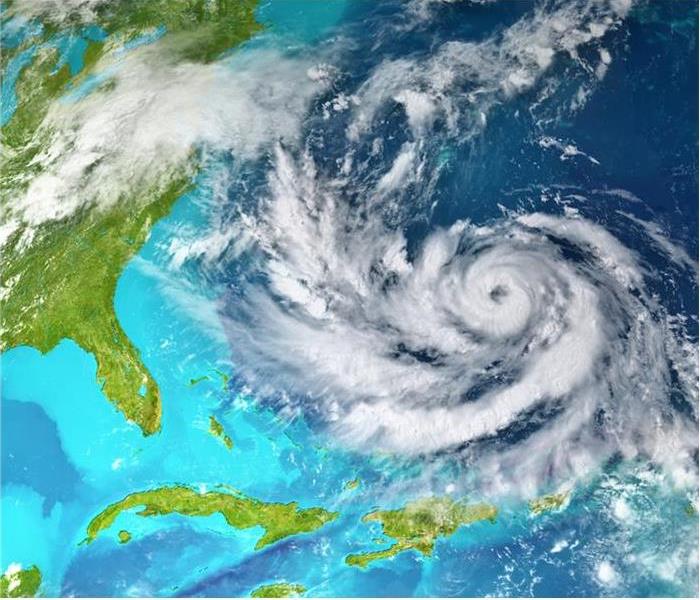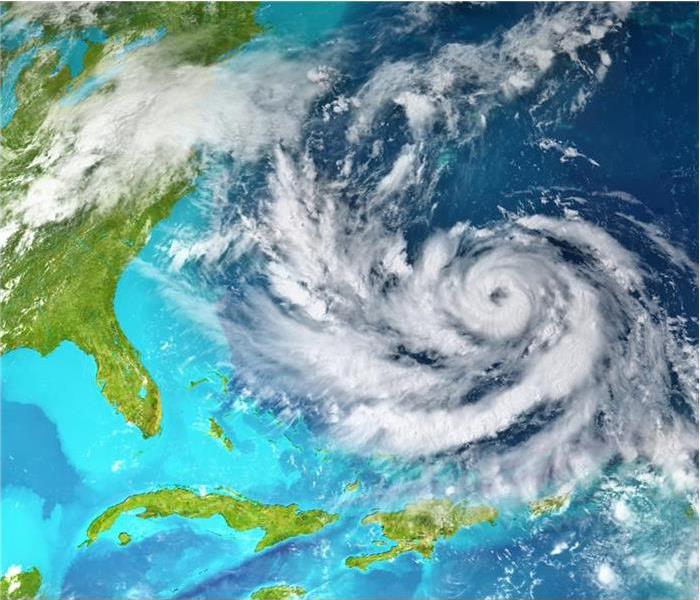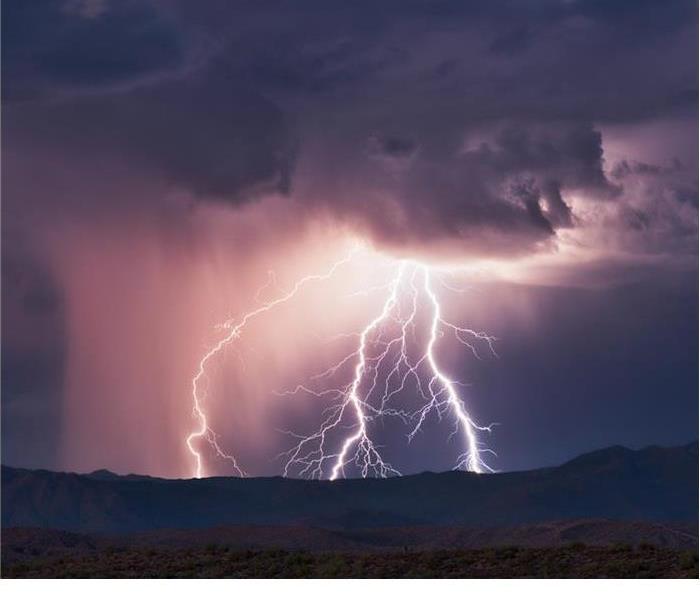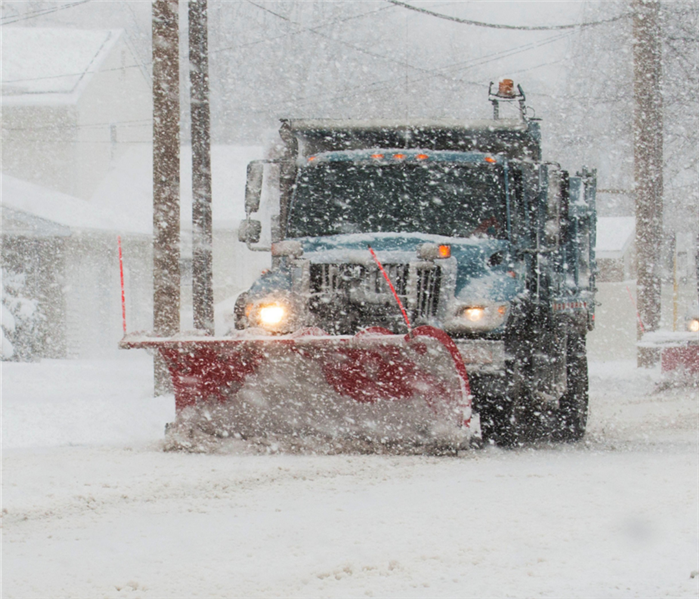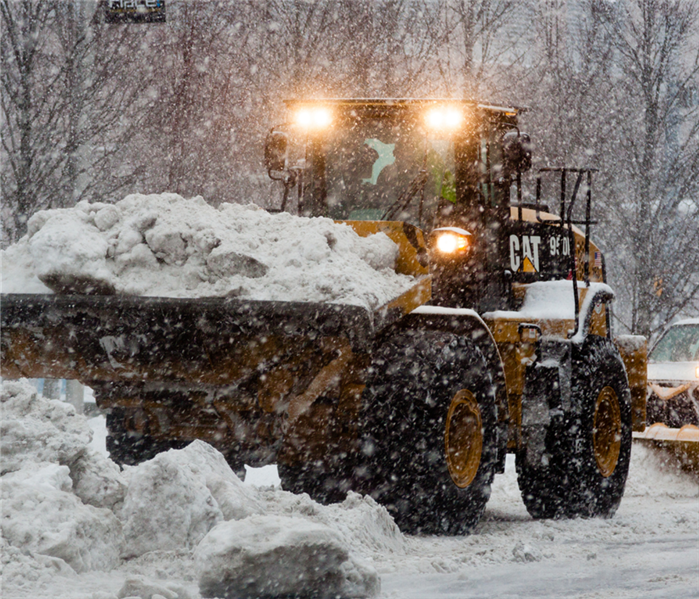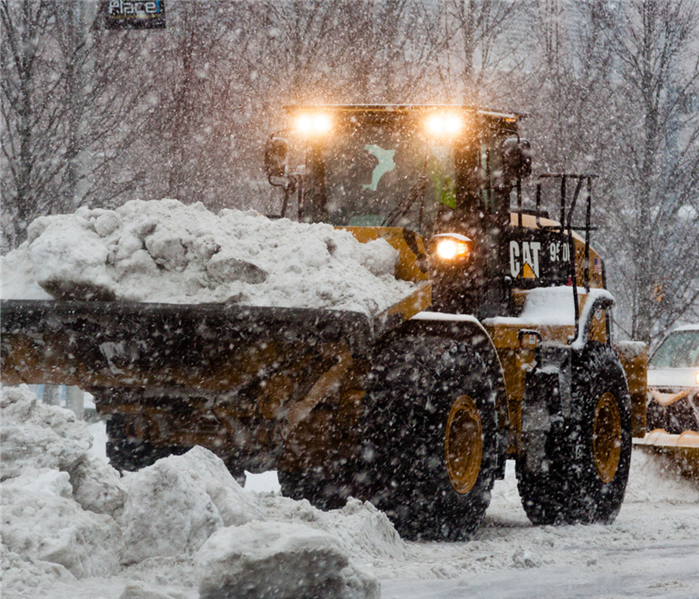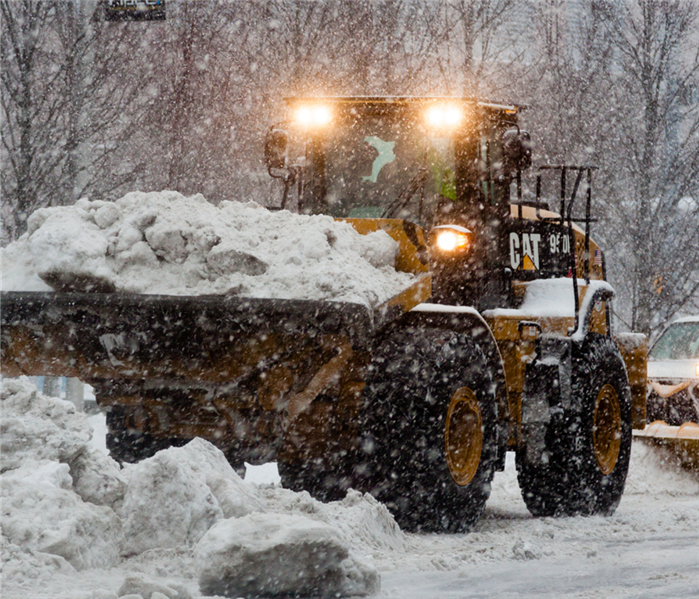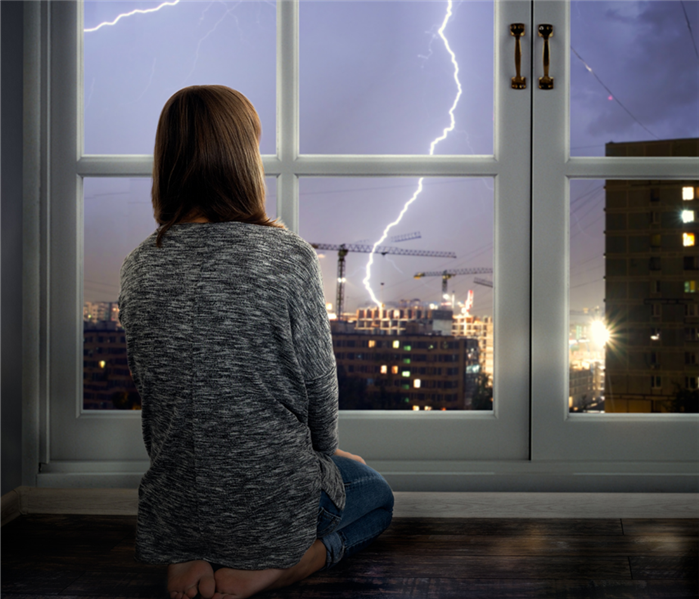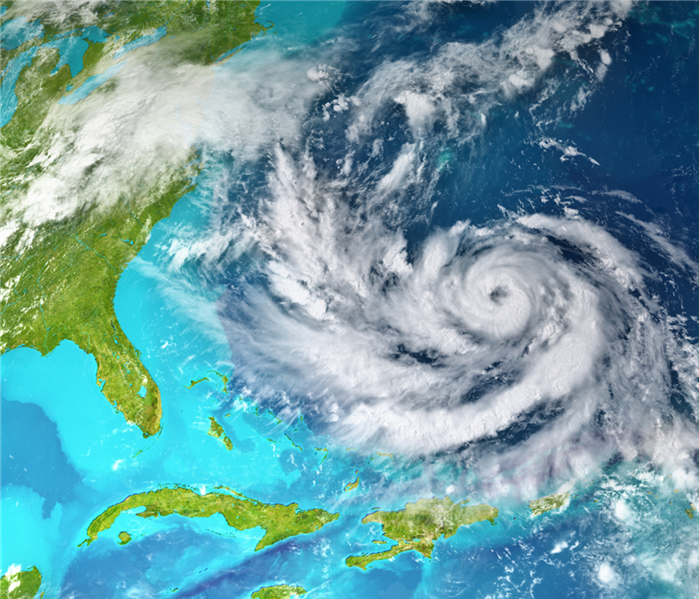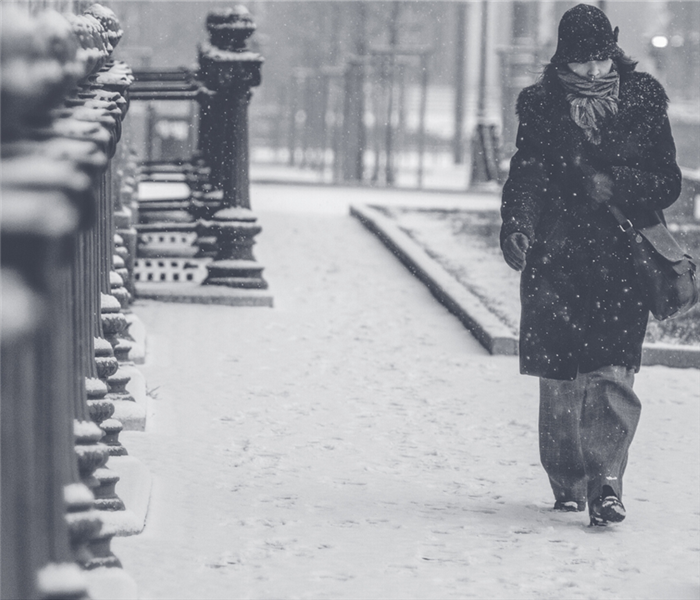Archived Storm Damage Blog Posts
Facts about Hurricanes
5/15/2024 (Permalink)
- Formation: Hurricanes form over warm ocean waters near the equator.
- Wind speed: Hurricanes can produce winds of up to 320 kilometers per hour, which can destroy buildings and rip up trees.
- Rain: Hurricanes can produce more than 2.4 trillion gallons of rain per day.
- Eye wall: The eye wall is the ring of thunderstorms and clouds that surrounds the eye, and it contains the heaviest rains and most violent winds.
- Categories: Hurricanes are categorized based on wind speed, with category 1 having speeds of 74–95 miles per hour, and category 5 having speeds of 157 miles per hour or higher. The higher the category, the more destruction and damage is caused.
- Rotation: In the northern hemisphere, hurricanes rotate counterclockwise, while in the southern hemisphere they rotate clockwise.
- Tornadoes: Hurricanes can produce tornadoes.
- Other names for hurricanes include cyclone, typhoon and tropical storm.
- Hurricanes have led to the death of around 2 million people over the last two years
Preparing Your Property for Summer Storms
6/14/2023 (Permalink)
The first day of summer is June 21st. While there is a lot to look forward to during summertime, we must also prepare ourselves and our properties for summer storms. Is your property prepared for summer storms? Let’s first dive into some of the effects summer storms can have on our homes and businesses.
Heavy rains, strong winds, thunder, lightning and even hail are produced by violent, summer weather which can turn into summer storms. Hurricanes, tornadoes, and thunderstorms can all be considered summer storms.
Heavy rains can cause severe flooding, excess moisture that can eventually turn into mold, and create leaks. Strong winds are known to break tree branches or can even result in the entire tree collapsing, which unfortunately can break windows, damage exteriors, etc. When this happens, debris can enter in your home. Lightning can start fires and damage electrical components while hail can damage roofing, siding, windows and more (as can lightning).
Here are some ways you can better protect your home or business:
- Review your insurance policy and consider adding flood insurance
- Seal doors and windows – this will help prevent water and wind from entering in your home
- Clean clogged gutters
- Have your roof inspected to ensure it is in good condition to withstand bad weather
- Remove dead branches from trees surrounding your property. If the entire tree is dead, it is worth having it removed – although it can be costly, it will prevent future damage and danger
- Consider installing storm windows and door(s)
Don’t forget - Protect yourself and your pets! Always keep an emergency kit on hand, take storm warnings seriously, keep pets indoors during bad weather, and shelter in place (cellar or basement preferably) during storms! We wish you a safe and enjoyable summer!
In the case of any unforeseen event, we are your local water and fire loss restoration company. We offer a variety of cleaning services, from gutter to carpet cleanings, as well. Feel free to reach out to us with any questions you may have at (410) 242-7370.
Hurricane Safety: Part 2
5/6/2022 (Permalink)
Atlantic Hurricane Season runs from June 1 - November 30. In anticipation of Hurricane Preparedness Week, we’re sharing safety information from FEMA and the National Weather Service to help you stay safe during a hurricane.
PART 2: STAY SAFE DURING THE STORM
Stay Informed
- Listen for emergency information and alerts.
- If told to evacuate by local officials, do so immediately.
Dealing with the Weather
- Determine how best to protect yourself from high winds and flooding.
- Take refuge in a designated storm shelter, or an interior room for high winds.
- If trapped in a building by flooding, go to the highest level of the building. Do not climb into a closed attic. You may become trapped by rising flood water.
- Do not walk, swim, or drive through flood waters. Turn Around. Don’t Drown! Just six inches of fast-moving water can knock you down, and one foot of moving water can sweep your vehicle away.
- Stay off bridges over fast-moving water.
Personal Safety
- If you must go to a community or group shelter remember to follow the latest guidelines from the Centers for Disease Control and Prevention (CDC) for protecting yourself and family from COVID-19.
- Be prepared to take cleaning items with you like soap, hand sanitizer, disinfecting wipes, or general household cleaning supplies to disinfect surfaces you may need to touch regularly.
- Maintain at least 6 feet between you and persons not part of your immediate family while at the shelter [by avoiding crowds or gathering in groups] as much as possible.
- Anyone over 2 years old should use a cloth face covering while at these facilities.
- Only use generators outdoors and away from windows.
—
Hurricanes can cause serious damage to your home and property. If you experience water or storm damage, SERVPRO of Catonsville is here to help: 410-242-7370.
Hurricane Safety: Part 1
5/5/2022 (Permalink)
Atlantic Hurricane Season runs from June 1 - November 30. As part of Hurricane Preparedness Week, we’re sharing safety information from FEMA and the National Weather Service to help you prepare.
According to ready.gov, “Hurricanes are dangerous and can cause major damage because of storm surge, wind damage, and flooding. They can happen along any U.S. coast or in any territory in the Atlantic or Pacific oceans. Storm surge is historically the leading cause of hurricane-related deaths in the United States.”
PART 1: PREPARE FOR A HURRICANE
Know your Hurricane Risk
Hurricanes are not just a coastal problem. Find out how rain, wind, water could happen where you live so you can start preparing now.
Make an Emergency Plan
Make sure everyone in your household knows and understands your hurricane plan. Discuss the latest Centers for Disease Control (CDC) guidance on Coronavirus (COVID-19) and how it may affect your hurricane planning. Don’t forget a plan for the office, kids’ daycare, and anywhere you frequent.
Gather Supplies
Have enough supplies for your household, include medication, disinfectant supplies, cloth face coverings, pet supplies in your go bag or car trunk.
Those with Disabilities
If you or anyone in your household is an individual with a disability identify if you may need additional help during an emergency.
Know your Evacuation Zone
You may have to evacuate quickly due to a hurricane. Learn your evacuation routes, practice with household, pets, and identify where you will stay.
Recognize Warnings and Alerts
Have several ways to receive alerts. Download the FEMA app and receive real-time alerts from the National Weather Service for up to five locations nationwide. Sign up for community alerts in your area and be aware of the Emergency Alert System (EAS) and Wireless Emergency Alert (WEA)- which requires no-sign up.
Review Important Documents
Make sure your insurance policies and personal documents like ID are up to date. Make copies and keep them in a secure password protected digital space.
Strengthen your Home
Declutter drains and gutters, bring in outside furniture, consider hurricane shutters.
Get Tech Ready
Keep your cell phone charged when you know a hurricane is in the forecast and purchase backup charging devices to power electronics.
Help your Neighborhood
Check with neighbors, senior adults, or those who may need additional help securing hurricane plans to see how you can be of assistance to others
Prepare your Business
Make sure your business has a continuity plan to continue operating when disaster strikes.
--
Hurricanes can cause serious damage to your home and property. SERVPRO of Catonsville has the skills and expertise to help. If you experience water or storm damage, call us: 410-242-7370.
Severe Thunderstorms - Watch vs. Warning
4/21/2022 (Permalink)
When a severe thunderstorm is imminent, the National Weather Service issues two types of alerts to the public: Watches and Warnings.
What's the difference?
Severe Thunderstorm Watch: Be Prepared!
Severe thunderstorms are possible in and near the watch area. Stay informed and be ready to act if a severe thunderstorm warning is issued. The watch area is typically large, covering numerous counties or even states.
Severe Thunderstorm Warning: Take Action!
Severe weather has been reported by spotters or indicated by radar. Warnings indicate imminent danger to life and property. Take shelter in a substantial building. Get out of mobile homes that can blow over in high winds. Warnings typically encompass a much smaller area (around the size of a city or small county) that may be impacted by a large hail or damaging wind identified by an NWS forecaster on radar or by a trained spotter/law enforcement who is watching the storm.
--
Severe storms can cause serious damage to your home and property. If you experience damage related to wind or water from a severe thunderstorm call us, we’re here to help: 410-242-7370.
—
About SERVPRO of Catonsville
SERVPRO of Catonsville specializes in the cleanup and restoration of residential and commercial property after a fire, smoke or water damage event. Our staff is highly trained in property damage restoration and we are an IICRC Certified Firm. SERVPRO of Catonsville is locally owned and operated—so we live and work here, too and we are proud to be part of the Catonsville community.
Storm Damage Restoration
2/20/2022 (Permalink)
SERVPRO of Catonsville specializes in storm damage restoration. Our crews are highly-trained and we use specialized equipment to restore your property to its pre-storm condition.
Why choose SERVPRO of Catonsville to help with your storm damage needs?
1. Faster Response
Since we are locally owned and operated, we can respond quicker with the right resources, which is extremely important. A fast response lessens the damage, limits further damage, and reduces the restoration cost.
2. Top Resources to Handle Floods and Storms
When a major storm event impacts Catonsville we can scale our resources to handle a large storm or flooding disaster. We have access to equipment and personnel from a network of 1,650 Franchises across the country and elite Disaster Recovery Teams that are strategically located throughout the United States.
Have Storm or Flood Damage? Call Us Today 410-242-7370
--
About SERVPRO of Catonsville
SERVPRO of Catonsville specializes in the cleanup and restoration of residential and commercial property after a fire, smoke or water damage event. Our staff is highly trained in property damage restoration and we are an IICRC Certified Firm. SERVPRO of Catonsville is locally owned and operated—so we live and work here, too and we are proud to be part of the Catonsville community.
Winter Storm Prep - Part 3
12/28/2021 (Permalink)
After the storm
When the storm has finally passed, it may be tempting to get back to life as usual but that may not be possible right away. In severe cases, it may take days or even weeks to thaw out and get back to normal.
Some tips for after a major winter storm:
- Only drive if necessary.
- Remove snow and ice from your tailpipe before starting your car and check regularly if idling.
- Clean all snow and ice from your car before driving.
- Dress in warm clothing, stay dry, and prevent prolonged exposure to cold and wind.
- Avoid overexertion clearing/shoveling snow. Overexertion can lead to a medical emergency.
- Monitor local news and alerts for emergency information and instructions.
Did your home or property suffer damage in the storm? If your home is damaged, no longer safe, and/or has lost power, you’ll need to get help as soon as possible. What are your options?
- You may want to go to a designated public shelter. Text SHELTER + your ZIP code (e.g., SHELTER 20472) to 43362 (FEMA) to find the nearest shelter in your area.
- Friends, family, and neighbors will likely be the first to provide help. Plan with neighbors now to help each other and share resources.
- Nonprofit and faith-based organizations often provide support immediately after a winter storm.
- If you or someone in your household has a disability, an access or functional need, and receives disability services, contact your local disability service provider for assistance.
- Insurance is an essential part of recovery. If you have insurance, you may receive financial compensation for some of your losses.
- Take pictures to document your damage and file a claim as soon as possible.
- Do what you can to prevent further damage (e.g., putting a tarp on a damaged roof) because insurance may not cover damage that occurs after the winter storm.
- Contact a leading restoration company, such as SERVPRO of Catonsville, to mitigate any damage and restore your property to its previous condition.
--
Have questions about winter storm prep or damage caused by storm conditions? We’re here to help. Call us at 410-242-7370.
Winter Storm Prep - Part 2
12/24/2021 (Permalink)
Scenario: A major storm has hit the Catonsville area. Your home is winterized, your vehicle is ready if necessary, and you’ve stocked up on supplies. What should you do now?
- Stay indoors. If you must go outside:
- Wear several layers of loose-fitting, lightweight, warm clothing rather than one layer of heavy clothing.
- Outer garments should be tightly woven and water-repellent.
- Wear mittens, which are warmer than gloves.
- Cover all of your body. Wear a hat and a scarf, covering your mouth to protect your face and to help prevent loss of body heat.
- Stay off the roads. If you must drive, make sure you have emergency supplies in your car.
- Close off rooms to consolidate and retain heat.
- Dress in layers and use blankets to stay warm.
- Bring pets into a warm place and out of the storm or severe cold.
- Never use a generator, camp stove, charcoal grill, or gasoline or propane heater indoors, as these items can start accidental fires, cause electric shock, and/or cause deadly carbon monoxide poisoning.
- Ensure space heater safety with THESE TIPS.
- Never heat a home with a cooktop or oven.
- Limit your time outdoors and stay dry.
- Regularly check the temperature inside your home, especially if you are over 65.
- Our ability to feel a change in temperature decreases with age.
- Older adults are more susceptible to health problems caused by cold.
You should also be aware of medical dangers during this time. Major concerns include frostbite and hypothermia.
More information on frostbite and hypothermia can be found on the CDC’s website.
--
Have questions about winter storm prep or damage caused by storm conditions? We’re here to help. Call us at 410-242-7370
Winter Storm Prep - Part 1
12/20/2021 (Permalink)
Winter storm season is here in Catonsville and if you haven’t already prepared for damaging weather, now is the time. Don’t wait until a storm hits to take safety measures to protect your home and family.
Winter storms can cause major issues including:
- Cold temperatures
- Power Failures
- Loss of communication services
- Icy roads
We’ve consulted CDC and FEMA guidelines to bring you a 3-part series on winter storm prep tips so you’re ready for anything when winter storms strike.
WHAT TO DO BEFORE A STORM (NOW)
- Sign up for local alerts and warnings.
- Create and test an emergency communication plan. Follow steps to create an emergency plan HERE.
- Stock up on EMERGENCY SUPPLIES.
- Install battery-powered or battery backed-up carbon monoxide detectors and smoke detectors.
- Winterize your home:
- Insulate any water lines that run along exterior walls so your water supply will be less likely to freeze.
- Caulk and weather-strip doors and windows.
- Insulate walls and attic.
- Install storm or thermal-pane windows or cover windows with plastic from the inside.
- Repair roof leaks and cut away tree branches that could fall on your home or other structure during a storm.
- Review your property insurance and safeguard critical documents.
- Keep an easy to read thermometer inside your home.
- Get trained on specific needs your family may have.
- Identify a place nearby where you can safely warm up should you lose heat in your home.
- Prepare your vehicle.
Have questions about winter storm prep or damage caused by storm conditions? We’re here to help. Call us at 410-242-7370.
What To Do In Severe Thunderstorms
8/2/2021 (Permalink)
As we move into thunderstorm season here in Maryland, are you prepared for a severe storm?
According to the National Weather Service, severe thunderstorms are officially defined as storms that are capable of producing hail that is an inch or larger or wind gusts over 58 mph.
Hail this size can damage property such as plants, roofs and vehicles. Wind this strong is able to break off large branches, knock over trees or cause structural damage to trees. Some severe thunderstorms can produce hail larger than softballs or winds over 100 mph. Thunderstorms also produce tornadoes and dangerous lightning; heavy rain can cause flash flooding.
What should you do to stay safe?
1. BEFORE A SEVERE STORM
- Be Weather-Ready: Check the forecast regularly to see if you're at risk for severe weather. Listen to local news or a NOAA Weather Radio to stay informed about severe thunderstorm watches and warnings. Check the Weather-Ready Nation for tips.
- Sign Up for Notifications: Know how your community sends warning. Some communities have outdoor sirens. Others depend on media and smart phones to alert residents to severe storms.
- Create a Communications Plan: Have a family plan that includes an emergency meeting place and related information. Pick a safe room in your home such as a basement, storm cellar or an interior room on the lowest floor with no windows. Get more ideas for a plan at: https://www.ready.gov/make-a-plan
- Practice Your Plan: Conduct a family severe thunderstorm drill regularly so everyone knows what to do if a damaging wind or large hail is approaching. Make sure all members of your family know to go there when severe thunderstorm warnings are issued. Don't forget pets if time allows.
- Prepare Your Home: Keep trees and branches trimmed near your house. If you have time before severe weather hits, secure loose objects, close windows and doors, and move any valuable objects inside or under a sturdy structure.
- Help Your Neighbor: Encourage your loved ones to prepare for severe thunderstorms. Take CPR training so you can help if someone is hurt during severe weather.
2. DURING A SEVERE STORM
- Stay Weather Ready: Continue to listen to local news or a NOAA Weather Radio to stay updated about severe thunderstorm watches and warnings.
- At Your House: Go to your secure location if you hear a severe thunderstorm warning. Damaging wind or large hail may be approaching. Take your pets with you if time allows.
- At Your Workplace or School: Stay away from windows if you are in a severe thunderstorm warning and damaging wind or large hail is approaching. Do not go to large open rooms such as cafeterias, gymnasiums or auditoriums.
- Outside: Go inside a sturdy building immediately if severe thunderstorms are approaching. Sheds and storage facilities are not safe. Taking shelter under a tree can be deadly. The tree may fall on you. Standing under a tree also put you at a greater risk of getting struck by lightning.
- In a Vehicle: Being in a vehicle during severe thunderstorms is safer than being outside; however, drive to closest secure shelter if there is sufficient time.
3. AFTER A SEVERE STORM
- Stay Informed: Continue listening to local news or a NOAA Weather Radio to stay updated about severe thunderstorm watches and warnings. More severe thunderstorms could be headed your way.
- Contact Your Family and Loved Ones: Let your family and close friends know that you're okay so they can help spread the word. Text messages or social media are more reliable forms of communication than phone calls.
- Assess the Damage: After you are sure the severe weather threat has ended, check your property for damages. When walking through storm damage, wear long pants, a long-sleeved shirt and sturdy shoes. Contact local authorities if you see power lines down. Stay out of damaged buildings. Be aware of insurance scammers if your property has been damaged.
- Help Your Neighbor: If you come across people that are injured and you are properly trained, if needed, provide first aid to victims until emergency response team members arrive.
Even with proper planning and precautions, severe storms can cause serious damage to your home and property. If you experience damage related to wind or water from a severe thunderstorm call us, we’re here to help: 410-242-7370.
—
About SERVPRO of Catonsville
SERVPRO of Catonsville specializes in the cleanup and restoration of residential and commercial property after a fire, smoke or water damage event. Our staff is highly trained in property damage restoration and we are an IICRC Certified Firm. SERVPRO of Catonsville is locally owned and operated—so we live and work here, too and we are proud to be part of the Catonsville community.
Hurricane Safety: Part 3 - After the Storm
5/7/2021 (Permalink)
Atlantic Hurricane Season runs from June 1 - November 30. As part of Hurricane Preparedness Week, we’re sharing safety information from FEMA and the National Weather Service to help you stay safe after a hurricane hits your community.
Part 3: RETURNING HOME AFTER A HURRICANE
- Listen to local officials for information and special instructions.
- Be careful during clean-up. Wear protective clothing and work with someone else.
- Do not touch electrical equipment if it is wet or if you are standing in water. If it is safe to do so, turn off electricity at the main breaker or fuse box to prevent electric shock.
- Avoid wading in flood water, which can contain dangerous debris. Underground or downed power lines can also electrically charge the water.
- Save phone calls for emergencies. Phone systems are often down or busy after a disaster. Use text messages or social media to communicate with family and friends.
- Document any property damage with photographs. Contact your insurance company for assistance.
--
Hurricanes can cause serious damage to your home and property. If you experience water or storm damage, SERVPRO of Catonsville is here to help. Call us: 410-242-7370
Thunderstorm Facts
2/24/2020 (Permalink)
Thunderstorms are defined as storms that produce thunder and lightning. Severe thunderstorms may also produce:
- Rain
- High winds
- Sleet or snow
It’s important to note that thunderstorms do not always produce moisture. A storm in which you see lightning and hear thunder but never feel a drop of water is known as a “dry” thunderstorm. Thunderstorms that produce hail and tornadoes are known as “supercell” storms. Storms occur either in clusters or lines; therefore, they may present as a single thunderstorm or as multiple thunderstorms hitting one after the other.
CAUSES
Thunderstorms are caused when moisture from the lower or mid-level part of the atmosphere mixes with warm, unstable air from the ground. Moisture and air then push upwards into the higher atmosphere to form clouds that produce thunder and lightning, as well as potential precipitation. Spring, summer and fall are most conducive to thunderstorms because the sun heats the ground and moisture is more perceptible in the air, especially in humid climates.
Thunderstorms must also be lifted to begin their formation. Some sources of lift include:
- More heat on the ground than in the air
- Changes in atmospheric conditions near mountains
- Weather front changes caused by clashing cold and hot air
- Drylines, or when moist and dry air clash
- Land or sea breezes
Any of these situations can immediately create a thunderstorm without warning, even in the middle of a clear blue day. In many cases, these storms will also be accompanied by lightning.
Have you experienced unexpected water or property damage from a storm? We’re here to help. Call us – 410-22-7370
--
About SERVPRO of Catonsville
SERVPRO of Catonsville specializes in the cleanup and restoration of residential and commercial property after a fire, smoke or water damage event. Our staff is highly trained in property damage restoration and we are an IICRC Certified Firm. SERVPRO of Catonsville is locally owned and operated—so we live and work here, too and we are proud to be part of the Catonsville community.
2019-2020 Baltimore Co. Winter Storm Data
2/21/2020 (Permalink)
Interested in how much winter costs here in Baltimore County? Check out the accumulation, salt use, and total costs for storms so far this winter season:
Storm #1: December 12, 2019 (2 a.m. – 7 a.m.)
- Accumulation: .50 inches (snow)
- Labor Cost: $65,948
- Tons of salt used: 29
Total Cost: $67,386
Storm #2: December 16, 2019 (3 a.m. – 8 p.m.)
- Accumulation: .50 inches (snow)
- Labor Cost: $69,465
- Tons of salt used: 1,277
Total Cost: $131,941
Storm #3: January 7, 2020 (3 p.m.) – January 8, 2020 (3 p.m.)
- Accumulation: 2 inches (snow)
- Labor Cost: $256,589
- Tons of salt used: 7,185
Total Cost: $608,277
Storm #4: January 18, 2020 (5 a.m.) – January 19, 2020 (midnight)
- Accumulation: .25 inches (snow & freezing rain)
- Labor Cost: $446,813
- Tons of salt used: 1,852
Total Cost: $537,472
You can also find a summary list of storm-related costs by fiscal year (dating back to 2001) on the Baltimore County website.
--
About SERVPRO of Catonsville
SERVPRO of Catonsville specializes in the cleanup and restoration of residential and commercial property after a fire, smoke or water damage event. Our staff is highly trained in property damage restoration and we are an IICRC Certified Firm. SERVPRO of Catonsville is locally owned and operated—so we live and work here, too and we are proud to be part of the Catonsville community.
Storm Safety Tips
1/30/2019 (Permalink)
Thunderstorm Safety Tips
To keep your home and family safe before and during a thunderstorm, it’s imperative that you take precautionary measures — especially if you live in an area prone to storms.
To prepare for a thunderstorm, we recommend:
- Putting together an emergency kit and family plan
- Removing debris and branches
- Securing outdoor objects that could blow away or damage the home
- Staying inside your home
- Closing all exterior windows and doors
- Unplugging all electronic equipment before the storm.
While there isn’t much you can do to prevent a severe thunderstorm, you can keep the damages to a minimum by securing as much in your home as possible and reinforcing the defenses around your home exterior. Tie down your roofing or seal it with mortar, call SERVPRO of Catonsville to clean up all the debris within and around your house.We are storm damage professionals who can come in following a natural disaster and help with the recovery. SERVPRO of Catonsville 410-242-7370
Thunderstorm Facts & Causes
1/30/2019 (Permalink)
Thunderstorms are defined as storms that produce thunder and lightning. Severe thunderstorms may also produce:
- Rain
- High winds
- Sleet or snow
It’s important to note that thunderstorms do not always produce moisture. A storm in which you see lightning and hear thunder but never feel a drop of water is known as a “dry” thunderstorm. Thunderstorms that produce hail and tornadoes are known as “supercell” storms. Storms occur either in clusters or lines; therefore, they may present as a single thunderstorm or as multiple thunderstorms hitting one after the other.
Causes
Thunderstorms are caused when moisture from the lower or mid-level part of the atmosphere mixes with warm, unstable air from the ground. Moisture and air then push upwards into the higher atmosphere to form clouds that produce thunder and lightning, as well as potential precipitation. Spring, summer and fall are most conducive to thunderstorms because the sun heats the ground and moisture is more perceptible in the air, especially in humid climates.
Thunderstorms must also be lifted to begin their formation. Some sources of lift include:
- More heat on the ground than in the air
- Changes in atmospheric conditions near mountains
- Weather front changes caused by clashing cold and hot air
- Drylines, or when moist and dry air clash
- Land or sea breezes
Any of these situations can immediately create a thunderstorm without warning, even in the middle of a clear blue day. In many cases, these storms will also be accompanied by lightning. Most will not come with hail or tornadoes, unless they occur in tornado-prone states such as Kansas, Oklahoma, Texas and Missouri.
Flooding In Your Home After A Storm
1/30/2019 (Permalink)
If your home is flooded following a severe thunderstorm, there are various steps you can take to recover your home. It’s going to be a long process, involve a lot of tearing up, remodeling and time, but your home will go back to its original state eventually. Some recommendations include:
- Wear safety gear.
- Get rid of anything that can’t be cleaned (bedding, fabric flooring, upholstery, toys, linens)
- Throw away drywall and insulation that’s wet.
- Deep clean and scrub hard surfaces with hot water and dish detergent.
- Use fans, A/C units and dehumidifiers to speed the drying process.
- Wash all clothing touched by flood water with hot water and laundry detergent.
Be aware of electrical power lines, natural gas lines, frayed wires and any other hazards from flooding that could injure you. You should check with the gas company or the fire department before returning to your home to avoid injury. Do not return to your home during the day to avoid any accidents from being unable to see. You shouldn’t be allowed to return until the police or fire department say it’s okay. You should also not wade in standing water or around downed power lines, just in case.
If you need help with the big part of the recovery job — pulling up carpet, taking down drywall, removing appliances, so forth — you can SERVPRO of Catonsville to help you 410-242-7370. These professionals are licensed and experienced in handling situations like flood recovery and know where to start. They can also look out for disaster-specific issues like mold, foundation issues and the like.
6 steps to prepare your family and home a thunderstorm before it hits Catonsville Md
1/9/2019 (Permalink)
6 steps to prepare your family and home a thunderstorm before it hits Catonsville Md
- Pick a safe place in your home to gather during a thunderstorm event: make sure its away from windows, skylights, and glass doors.
- Make a list of items to be brought inside if a thunderstorm is on its way
- Make trees and shrubbery more wind tolerant by keeping them trimmed and removing damaged branches
- Protect your pets by making sure they are inside, or in a safe, secure barn.
- If you are considering installing lightning rods, consult your fire department
- Put together an emergency kit
Review this step-by-step plan with your family.
We are Flooded Business Specialists:
- We are Available 24 hours/7 days per week
- We’re a Preferred Vendor to many National Insurance Companies
- We Bill The Insurance Directly – One Less Thing For You To Worry About
- Our Technicians are Highly-Trained in water Restoration Techniques
- We use s500 IICRC Restoration Standards
- Advanced Inspection and Extraction Equipment
Storm/Wind Damage
11/17/2017 (Permalink)
Winds can reach at least 300 miles per hour during a severe thunderstorm, which can rip siding off your home and exacerbate the pelting of your exterior with hail and debris as well. Wind damage repairs can cost thousands of dollars, depending on the extent of the injury. While you can’t prepare for flying debris from other houses, you can minimize damage by curtailing debris in your own yard. To prevent wind damage, you can:
- Trim back tree branches to prevent fallen limbs.
- Secure window shutters to defend against debris.
- Tie down anything that could fly away and hit the siding or the roof.
If your siding is looking worse for wear, have a siding professional come out to repair it. It could make the difference in whether you’re left with an intact home exterior after a storm or not.
Storm/Tornado Damage
11/17/2017 (Permalink)
Tornado damage occurs following high winds from blowing debris. While you can’t do a lot to prepare your home for a tornado, it helps to trim tree branches back from your roof and windows. You can also reinforce your roof to better handle high winds:
- Shake roof: Add more nails.
- Slate roof: Seal down with cement.
- Tile roof: Place a steel strap over the tiles.
- Asphalt roof: Nothing can be done, but inspect after.
You can also invest in a storm cellar, which is built underground and allows great defense against high winds during a tornado. A storm shelter is built close to the home so you have easy access during a tornado and don’t have to run far for safety. A storm cellar door is built at an angle so that debris blows over the door. This allows for debris to roll over the door rather than trap it, so you can get in and out easily. The confines of a storm cellar for a family is around 8 by 12 feet with an arched roof. It’s made of cement blocks and rebar to ensure maximum defenses.
Hurricane Facts
11/8/2017 (Permalink)
A hurricane is an intense tropical storm with powerful winds and heavy rain.
Other names for a hurricane include cyclone, typhoon and tropical storm.
While they are essentially the same thing, the different names usually indicate where the storm took place. Tropical storms that form in the Atlantic or Northeast Pacific (near the United States) are called hurricanes, those that form near in the Northwest Pacific (near Japan) are called typhoons and those that form in the South Pacific or Indian oceans are called cyclones.
Hurricanes usually form in tropical areas of the world.
Hurricanes develop over warm water and use it as an energy source.
Hurricanes lose strength as they move over land.
Coastal regions are most at danger from hurricanes.
As well as violent winds and heavy rain, hurricanes can also create tornadoes, high waves and widespread flooding.
Hurricanes are regions of low atmospheric pressure (also known as a depression).
The wind flow of hurricanes in the southern hemisphere is clockwise while the wind flow of hurricanes in the northern hemisphere is counterclockwise.
Weather in the eye of a hurricane is usually calm.
The eye of a hurricane can be anywhere from 2 miles (3.2 kilometres) in diameter to over 200 miles (320 kilometres) but they are usually around 30 miles (48 kilometres).
The winds around the eye of a hurricane are usually the strongest.
Hurricanes can be tracked by weather satellites and weather radar closer to land.
Hurricanes have led to the death of around 2 million people over the last 200 years.
The 1970 Bhola Cyclone that struck Bangladesh killed over 300000 people.
In 2005 Hurricane Katrina killed over 1800 people in the United States and caused around $80 billion dollars worth of property damage. The city of New Orleans was hit particularly hard with levee breaches leading to around 80% of the city being flooded.




 24/7 Emergency Service
24/7 Emergency Service
